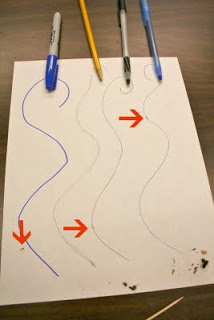An Introduction to Scientific Inquiry
| This initial lab of the semesters
sets the tone for the student-directed and
inquiry-based nature of this lab experience.
The intent of this lab is to engage students in
the process of doing science and to reveal and
refine/reform their conceptions about the nature
of science and the methods scientists use to study
nature. Lab Summary In this lab students observe the behavior of termites exposed to a “trail” made by a black ballpoint ink pen. After initially observing the termites' behavior student teams develop a question they would like to explore regarding a specific observation. Teams then pose their own hypothesis, protocol for testing their hypothesis (using available lab materials), and predicted results, which would both support and refute their hypotheses. The lab culminates with groups presenting their proposal to the class. These presentations are meant to have students explore their initial conceptions of how scientists go about seeking answers to a biological question. Each presentation is discussed, weighing the strengths and weaknesses. Students are asked to rewrite their proposals based on the class discussion. The end of lab discussion also focuses on several reflection questions about key aspects of scientific discovery (sources of variation, sampling design, describing data, & naturalism). Watch a video of the termite trails by clicking on the picture. |
Scientific
Skills - students will practice and receive
feedback on the following skills:
- constructing scientific hypothesis and experimental prediction
- designing an experiment that controls for variables across treatments and trials.
- designing quantitative measures of biological features in nature and reflect on their value with regard to objectivity, precision, and accuracy.
- reflecting on the purpose of random assignment of subjects to treatments in order to control for selection bias.
- exploring the proper types of graph to summarize/describe a data set.
- drawing a graph which contains all of the essential features required to clearly, concisely and comprehensively summarize a data set (i.e. figure caption, measures of variation, axis labels, units of measure). reflecting on the importance of sample size in generalizing results to the population.
- exploring the source of limitations in the conclusions one can draw from scientific experiments.
- exploring the difference between naturalistic (scientific) and non-naturalistic (non-scientific) hypotheses.
Learning Theory & Pedagogy
Learning is an on-going process in which new
understanding is constructed from new information, but
which is tempered by the learners’ prior conceptions
(and misconceptions). Research in cognitive
science also shows that our own familiar and personally
comfortable conceptions often get in the way of
constructing a new, but more accurate
understanding. This is particularly true for
individuals who are novices in the content area being
explored. For these reasons, this initial lab will
allow students to actively explore, reveal, discuss and
correct their own preconceptions about scientific
inquiry by conducting and reflecting on an experiment of
their own design.
Instructional Resources
- An instructor guide which provide lab instructors with pre-lab preparation instructions, suggested materials, learning theory and pedagogical suggestions including common conceptions expressed by students and suggestions for leading the end of lab class discussion of team proposals.
- An opening and engaging audio case study (from WNYC's Radiolab) intended to challenge students' conceptions and encourage deeper considerations of the nature of scientific hypotheses.
- Instructor PowerPoint presentation which guides students through the different stages of the lab.
